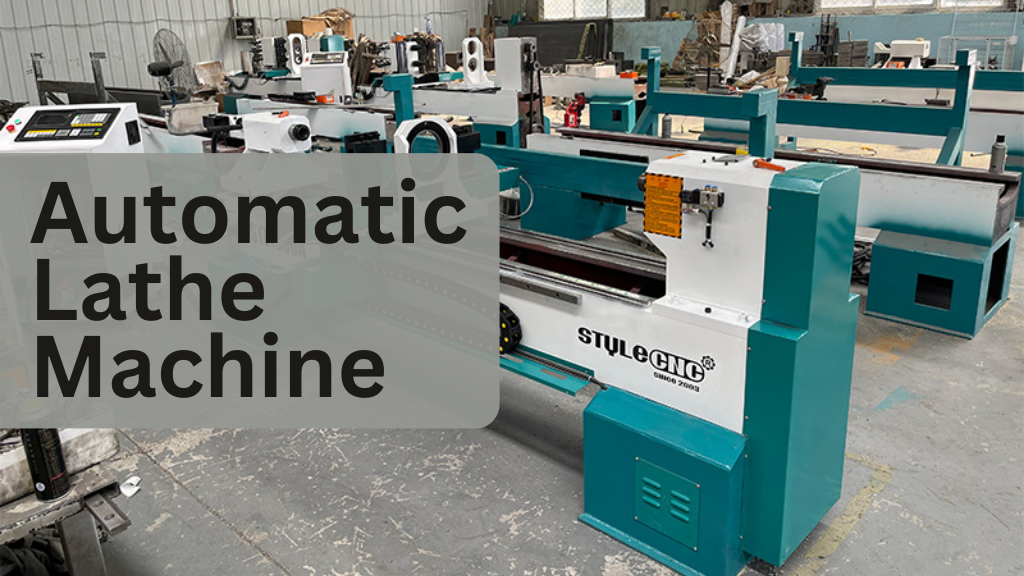The automatic lathe machine has transformed the world of manufacturing by allowing industries to produce precise, high-volume components with minimal human supervision. Unlike traditional lathes that require constant attention from skilled operators, automatic lathes can run continuously, performing multiple operations with high accuracy. This shift has led to faster production cycles, reduced labor costs, and improved product quality across a wide range of industries.
From the production of medical implants to the creation of automotive engine parts, automatic lathes are central to modern industrial growth. In this guide, you will learn everything about automatic lathe machines including their definition, history, types, applications, advantages, limitations, buying considerations, real-world use cases, and their future in global manufacturing.
What is an Automatic Lathe Machine
An automatic lathe machine is a precision metal-cutting tool that can operate independently once it is set up. It automates the process of feeding, cutting, drilling, threading, and shaping materials, typically metals, into finished components. Unlike a manual lathe that requires constant human control, automatic lathes are designed to perform repetitive operations without operator intervention, making them ideal for mass production.
The defining characteristics of an automatic lathe include:
- Continuous production with minimal supervision
- Ability to create complex shapes and parts
- High repeatability and consistency
- Reduced reliance on operator skill
In simple terms, an automatic lathe machine is a vital tool for manufacturers that want efficiency, speed, and accuracy in large-scale production.
History and Evolution of Automatic Lathe Machines
The story of automatic lathes is closely tied to the industrial revolution and the growing need for precision engineering.
-
Early Development
The first lathes can be traced back thousands of years, but true automation emerged in the late nineteenth century when industries began seeking faster ways to produce screws, bolts, and small mechanical components. Watchmakers and gunsmiths were among the earliest adopters of automatic lathes, as their industries demanded high precision.
-
Swiss-Type Innovation
Around the early 1900s, the Swiss-type automatic lathe was developed. It introduced a sliding headstock mechanism that allowed extremely slender parts to be machined with high accuracy. This innovation was particularly useful in watchmaking and later found applications in the production of surgical instruments and aerospace components.
-
Numerical Control and CNC Era
By the mid-20th century, numerical control systems were introduced. These machines could follow coded instructions to produce parts, reducing the reliance on mechanical cams. With the development of computers, CNC or Computer Numerical Control lathes were born. CNC lathes represented a giant leap forward by enabling programmable machining of complex geometries.
-
Modern Smart Manufacturing
Today, automatic lathes are integrated into smart factories with Industry 4.0 technologies. Machines are now capable of self-monitoring, predictive maintenance, and real-time data sharing through the Internet of Things. Artificial intelligence and digital twin simulations further improve performance, efficiency, and sustainability.
Types of Automatic Lathe Machines
Automatic lathes come in several variations, each serving a unique purpose.
Swiss-Type Automatic Lathe
- Offers extreme precision for small, delicate parts
- Uses a sliding headstock for better stability
- Commonly used in medical devices, watch components, and aerospace parts
Turret Automatic Lathe
- Equipped with a turret that holds multiple tools
- Reduces downtime by switching tools quickly
- Ideal for medium to high-volume production of complex parts
Single-Spindle Automatic Lathe
- Works on one workpiece at a time
- Best for simpler, smaller-scale production
- Cost-effective for businesses with moderate output needs
Multi-Spindle Automatic Lathe
- Capable of machining multiple workpieces at once
- Increases productivity for mass production industries
- Widely used in fastener and automotive component manufacturing
CNC Automatic Lathe
- Fully computerized and programmable
- Handles intricate designs and multi-axis machining
- Offers flexibility and adaptability across industries
Applications of Automatic Lathe Machines
Automatic lathes are versatile and widely used in industries where precision and efficiency are critical. They serve multiple sectors, producing both large-scale industrial components and delicate, finely crafted parts.
-
Automotive Industry
In the automotive sector, automatic lathes are essential for producing high-precision parts such as engine components, gear shafts, bolts, nuts, and fasteners. Their ability to handle mass production ensures consistency, reliability, and cost efficiency. This makes them vital in maintaining high-quality standards in vehicle manufacturing.
-
Aerospace Industry
The aerospace industry demands lightweight yet durable components, and automatic lathes meet this need effectively. They are used to craft turbine blades, fasteners, and control elements with extreme accuracy. Their precision machining helps meet strict safety and performance standards in aircraft production.
-
Medical Industry
Automatic lathes are widely used in the medical field for manufacturing surgical tools, dental implants, orthopedic screws, and prosthetic devices. These machines ensure the accuracy and surface finish required for medical applications. Their efficiency also supports large-scale production of life-saving instruments.
-
Electronics Industry
In electronics, automatic lathes produce intricate components like precision connectors, housings, and micro-parts for circuits. These machines can manufacture small-scale parts with high repeatability, ensuring flawless performance in gadgets. Their precision contributes to the advancement of modern electronic devices.
-
Defense and Firearms
The defense sector relies on automatic lathes for producing highly accurate components such as gun barrels, firing pins, and trigger mechanisms. Precision machining is crucial here, as even minor deviations can affect performance. These machines ensure durability and compliance with strict defense standards.
-
Watchmaking and Jewelry
Watchmaking and jewelry industries use automatic lathes for creating intricate gears, casings, and decorative elements. Their precision enables the production of detailed designs and smooth finishes. This makes them essential in crafting luxury items that require both functionality and artistry.
Advantages of Automatic Lathe Machines
Automatic lathes have become a key asset for industries aiming to achieve faster production and higher precision. Their advanced capabilities make them suitable for both small workshops and large-scale industries, offering long-term reliability and efficiency.
-
High Efficiency
One of the biggest advantages of automatic lathes is their ability to produce thousands of identical parts without interruptions. This continuous workflow ensures that industries can meet high demand while maintaining speed and consistency.
-
Precision and Consistency
Automatic lathes are designed to deliver exact specifications with minimal errors. Each part produced matches the required dimensions, ensuring quality and consistency that is difficult to achieve with manual operations.
-
Cost Savings
By reducing dependency on manual labor, these machines help industries cut operational costs. They also minimize material wastage during production, making them a cost-effective solution in the long run.
-
Scalability
Whether for small-scale requirements or mass production, automatic lathes provide flexibility. Manufacturers can scale production levels easily, depending on market demand or specific project needs.
-
Multi-Functionality
Another strong advantage is the ability to perform multiple machining processes in a single setup. This reduces the need for several machines, saving both time and production space.
-
Durability and Reliability
Automatic lathes are built to handle continuous operation in demanding environments. Their durability ensures smooth performance, reducing downtime and maintenance requirements.
Limitations of Automatic Lathes
Despite their many strengths, automatic lathes come with certain limitations that industries must evaluate before making an investment. These drawbacks often relate to cost, technical expertise, and long-term maintenance.
1. High Initial Cost
Advanced CNC and multi-spindle automatic lathes require a significant upfront investment. For small businesses, this can be a major challenge, especially when compared to conventional lathes.
2. Complex Setup and Programming
Automatic lathes, particularly CNC models, demand skilled operators to manage setup and programming. Without proper training, the efficiency and precision of the machine can be compromised.
3.Maintenance Expenses
Regular maintenance, servicing, and replacement of spare parts can add to operational costs. Industries must account for these ongoing expenses when budgeting for automation.
4. Limited Flexibility in Older Models
Traditional cam-operated automatic lathes lack the flexibility to adapt to frequent design changes. This makes them less suitable for industries requiring constant product modifications.
Buying Guide: Choosing the Right Automatic Lathe Machine
When investing in an automatic lathe machine, businesses must carefully assess their production goals and operational requirements. The right choice can improve efficiency, reduce costs, and ensure long-term reliability. Below are key factors to consider before making a purchase.
-
Production Volume
Industries with high-volume demands benefit most from multi-spindle automatic lathes, as these machines can produce large batches quickly. On the other hand, smaller manufacturers or custom part makers may find single-spindle or CNC lathes more practical. Matching production capacity to business needs ensures cost-effectiveness.
-
Part Size and Design Complexity
CNC automatic lathes are ideal for intricate designs, precision drilling, and parts that require detailed finishing. For slender or elongated parts, Swiss-type lathes are the most effective option. Choosing the correct machine type based on part size and complexity helps maintain accuracy and reduces rework.
-
Budget Considerations
The upfront cost of automatic lathes can vary widely depending on the type and technology. Businesses should strike a balance between affordability and long-term returns. While advanced CNC and multi-spindle models may seem expensive, they often reduce labor costs and material wastage over time, providing higher value.
-
Brand Reliability
Opting for a reputable manufacturer ensures better machine quality, durability, and after-sales service. Well-established brands usually have a strong track record, making it easier to access spare parts, software updates, and technical assistance. A trusted brand also adds confidence to the investment.
-
Software Compatibility
For CNC lathes, software integration plays a major role in smooth operation. Buyers should confirm that the machine is compatible with their existing CAD/CAM systems. Compatibility reduces downtime, prevents errors, and allows for efficient workflow integration across the production line.
-
Maintenance and Support
Regular maintenance is essential to keep automatic lathes in peak condition. Businesses should choose suppliers that provide technical training, quick access to spare parts, and responsive customer service. Strong support ensures minimal downtime and keeps production running smoothly.
Real-World Example: Automatic Lathes in Medical Manufacturing
A medical equipment manufacturer in the United States adopted Swiss-type automatic lathes to produce titanium bone screws. Previously, the company relied on conventional machining which was slower and produced more errors. With the switch, production time dropped by 60 percent and quality improved dramatically, reaching a 98 percent defect-free rate. This not only saved costs but also ensured faster delivery of essential medical supplies, ultimately improving patient care.
Automatic Lathe Machine vs Traditional Lathe
| Feature | Automatic Lathe Machine | Traditional Lathe Machine |
|---|---|---|
| Operator Involvement | Minimal | High |
| Production Speed | Very High | Moderate |
| Precision | Extremely High | Dependent on operator skill |
| Cost Efficiency | Better long-term return on investment | Lower upfront cost |
| Best Use | Mass production and precision parts | Small workshops and custom projects |
Maintenance Tips for Automatic Lathes
Proper care ensures the longevity and reliability of automatic lathe machines.
- Lubricate moving components regularly
- Monitor coolant levels and replace when required
- Keep spindles and tools properly aligned
- Clean machine parts after every production cycle
- Schedule routine maintenance and inspections
- Replace worn-out parts before breakdowns occur
These practices help reduce downtime and extend machine lifespan.
Future of Automatic Lathe Machines
The future of automatic lathe technology is closely linked with advancements in digital manufacturing.
- Artificial intelligence will make machines more adaptive with predictive adjustments
- Industry 4.0 integration will allow seamless sharing of performance data across networks
- Eco-friendly designs will prioritize energy-efficient motors and recyclable coolants
- Customization on demand will become easier with digital twin technology and advanced simulation
These innovations will ensure automatic lathes remain a core technology in next-generation factories.
Conclusion
The automatic lathe machine has become a foundation of modern manufacturing. It offers precision, efficiency, and scalability that traditional methods cannot match. From producing medical implants that save lives to crafting intricate aerospace components, automatic lathes are central to industrial innovation.
While the investment may be significant, the long-term rewards in terms of cost savings, production speed, and quality make automatic lathes a wise choice for businesses of all sizes. As industries continue to evolve with smart technologies and automation, automatic lathes will remain at the forefront, driving progress in global manufacturing.
FAQs
What is the main function of an automatic lathe machine
The primary function is to automate cutting and shaping operations with minimal supervision, ensuring consistency and efficiency.
Are automatic lathes only used in large factories
No. While they are popular in large-scale industries, smaller workshops also use compact CNC lathes for custom projects and medium production runs.
How much does an automatic lathe machine cost
The price can range from around twenty thousand dollars to more than two hundred and fifty thousand dollars, depending on the model and features.
What industries rely most on automatic lathes
The automotive, aerospace, electronics, defense, and medical industries are among the biggest users of automatic lathes.
What is the difference between CNC lathes and mechanical automatic lathes
CNC lathes are computer-controlled, more versatile, and capable of complex designs, while mechanical automatic lathes rely on cams and gears and are better suited for simpler tasks.




